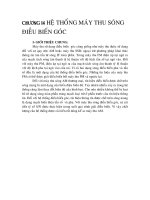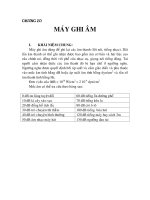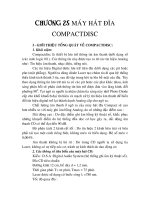Tài liệu ô nhiễm đất và kỹ thuật xử lí - TÓM TẮT LỊCH SỬ CỦA VẤN ĐỀ Ô NHIỄM
Bạn đang xem bản rút gọn của tài liệu. Xem và tải ngay bản đầy đủ của tài liệu tại đây (579.01 KB, 12 trang )
A Historical Overview
of the Development of
Clean Air Regulations
1.1 A BRIEF HISTORY OF THE AIR POLLUTION PROBLEM
Media reports about air pollution might lead us to think of air pollution as being
something that developed in the second half of the 20th century. But this is not so.
The kind of air pollution to which human beings have been exposed has changed
with time, but air pollution has been known in larger cities at least from the
14th century when people first started using coal for heating their homes.
1
In England, during the reign of Edward I, there was a recorded protest by the
nobility about the use of “sea” coal which burned in an unusually smoky manner.
Under his successor, Edward II (1307–1327), a man was put to torture for filling
the air with a “pestilential odor” through the use of coal. Under the reigns of
Richard III and Henry V, England undertook to restrict the use of coal through
taxation. Nevertheless, the situation continued to grow worse in the larger cities, so
much so that during the reign of Elizabeth I (1533–1603, Queen, 1550–1603)
Parliament passed a law forbidding the use of coal in the city of London while
Parliament was in session. While this may have eased the pollution for the parlia-
mentarians, it did very little to actually solve the problem.
As cities grew and the Industrial Revolution developed, the spread of coal smoke
grew. In 1686, a paper was presented to the Royal Philosophical Society on “An
Engine That Consumes Smoke.” To this day we have been working on this same
problem, as yet to no avail. Legislation that was introduced often ignored the
technical aspects of the problem, and hence was unenforceable. For example, a law
passed by Parliament in 1845 stated that locomotives must consume their own smoke,
which would be grand but, of course, it is not realizable.
The air pollution problem in the U.S. was first recognized as being due to coal
smoke. In 1881 Chicago adopted a smoke control ordinance. St. Louis, Cincinnati,
and other cities also adopted smoke ordinances in the years that followed. In these
early years, it was established that the responsibility rested with the state and local
governments.
Nashville, Tennessee had a population of 80,865 in 1900, and it was a typical
community of that period that depended on bituminous coal for heating. A short
story written by O’Henry describes his visit to Nashville in 1900 as follows:
1
9588ch01 frame Page 1 Wednesday, September 5, 2001 9:39 PM
© 2002 by CRC Press LLC
A M
UNICIPAL
R
EPORT
Nashville — a city, port of delivery, and the capital of the state of Tennessee, is on the
Cumberland River and on the N.C. & St. L. and the L&N Railroads. This city is
regarded as the most important educational centre in the South. I stepped off the train
at 8 P.M. Having searched thesaurus in vain for adjectives, I must, as a substitution,
hie me to comparison in the form of a recipe:
“ Take of London fog, thirty parts; malaria, ten parts; gas leaks, twenty parts; dewdrops
gathered in a brick-yard at sunrise, twenty-five parts; odor of honeysuckle, fifteen parts.
Mix. The mixture will give you a approximate conception of a Nashville drizzle. It is
not so fragrant as a moth ball, nor as thick as pea soup; but ’tis enough — ’twill serve.”
From 1930 to 1941, the focus of air pollution was on smoke control laws. Public
protest groups from Chicago, St. Louis, Cincinnati, and Pittsburgh had some success.
However, air pollution was not recognized as the health hazard we know it to be
today.
In 1941 war was declared on the Axis Powers of Germany and Japan and their
allies, and from late 1941 until 1945, there was an all-out effort to defeat these
countries. This effort allowed no time nor materials for air pollution control. Smoke
levels reached new highs as the national effort rallied to the war. Finally with a
return to peace, action on pollution control was initiated.
In the prewar era, Pittsburgh had enacted a stringent new control regulation. In
October 1946, a regulation which centered on the type of coal used was put into
effect. Then, in October of 1948, tragedy struck at Donora, Pennsylvania.
2
Weather
conditions were perfect for a stagnating inversion. As the inversion deepened, people
in Donora became ill, and 20 died from the effects of the excessive air pollution
which was prevalent. The result was an awakening to the health hazards of air
pollution. Other such incidents were recognized throughout the world as indicated
in Table 1.1 compiled from several sources.
2-4
Thus, October 1948 marks the start of a more vigorous program of air pollution
control in the U.S. For example, on May 1, 1949 the Pittsburgh smoke ordinance
was extended to the whole of Allegheny County. Air pollution abatement was soon
to attract the public’s eye and money, but it wasn’t until the advent of the Clean Air
Act of 1963 that there was a national awakening to the value of our air environment.
During World War II a new type of air pollution had been discovered in the
Los Angeles atmosphere. New effects were manifest in the form of eye and skin
irritation and plant damage not evident from simple smoke pollution. It was the
result of a photochemical smog that was at first attributed to the oil refineries and
storage facilities. When controls of these facilities did not result in a significant
reduction of the problem, it was then discovered that the internal combustion engine
was a major cause of this new type of pollution. The result of photochemical
oxidation is seen in the brown haze apparent in the upper layer of the atmosphere.
The brown haze is a mixture of particulates, oxides of nitrogen, sulfuric-acid mist
condensed from the oxidation of sulfur dioxide, and particles produced from pho-
tochemical reaction in the atmosphere. The haze limits visibility, decreases the
9588ch01 frame Page 2 Wednesday, September 5, 2001 9:39 PM
© 2002 by CRC Press LLC
amount of sunlight reaching the earth, results in an increase in the amount of cloudy
weather present, and, when it accumulates, results in all the unpleasant effects we
associate with air pollution.
Perhaps it was in response to these visual signs of air pollution that people could
see occurring that the nation decided to act. Most certainly it was at this point that
the federal government entered the picture.
1.2 FEDERAL INVOLVEMENT IN AIR POLLUTION CONTROL
After the World War II and the advent of the air pollution episodes in Donora and
London, it became apparent that a more concerted federal action was required.
Congress first passed an air pollution law in 1955. At this time, Congress was
particularly reluctant to interfere in states’ rights, and early laws were not strong.
These laws more or less defined the role of the federal government in research and
training in air pollution effects and control. The following brief summary leads up
to the 1970 Amendments to the Clean Air Act, beginning with:
The Air Pollution Control Act of 1955, Public Law 84-159, July 14, 1955
• Left states principally in charge of prevention and control of air pol-
lution at the source
• Recognized the danger to the population of the growing problem
• Provided for research and training in air pollution control
TABLE 1.1
The Horrible Total-Man Breathes, Coughs, and Dies
Location Date Deaths*
Reported
Illness Common Conditions
Meuse Valley, Belgium 12/1/30 63 6000 Low atmospheric dilution
Donora, PA 10/26/48 18 5900 (43%) Fog and gaseous materials
London 11/26/48 700–800
Poza Rica, Mexico 11/21/50 22 >320
London 12/5/52 3500–4000 Unknown
New York, NY 11/22/53 175–260 Unknown
London 11/56 1000 Unknown
London 12/2/57 700–800
London 1/26/59 200–250
London 12/5/62 700 Unknown
London 1/7/63 700
New York, NY 1/9/63 200–400
New York, NY 11/23/66 170
*Number of deaths above expected average death rate.
9588ch01 frame Page 3 Wednesday, September 5, 2001 9:39 PM
© 2002 by CRC Press LLC
Air Pollution Control Act Amendments of 1960, Public Law 86-493, June 6,
1960 and Amendments of 1962, Public Law 87-761, October 9, 1962
• Directed the Surgeon General to conduct a thorough study of the effects
of motor vehicle exhausts on human health
The Clean Air Act of 1963, Public Law 88-206, December 1963
• Encouraged state and local programs for the control and abatement of
air pollution while reserving federal authority to intervene in interstate
conflicts
• Required development of air quality criteria which would be used as
guides in setting ambient and emission standards
• Provided research authority to develop methods for removal of sulfur
from fuels
Motor Vehicle Air Pollution Control Act of 1965, Public Law 89-272, October 20,
1965
• Recognized the technical feasibility of setting automobile emission
standards
• Determined that such standards must be national standards and rele-
gated automotive emission control to the federal government
• Gave the state of California waivers to develop standards more appro-
priate to the local situation
The Air Quality Act of 1967, Public Law 90-148, November 21, 1967
• Designated air quality control regions (AQCRs) within the USA, either
inter- or intrastate
• Required issuance of air quality criteria
• Required states to established air quality standards consistent with air
quality criteria in a fixed time schedule
• Gave states primary responsibility for action, but a very strong federal
authority was provided
• Required development and issuance of information on recommended
air pollution control technique
The Clean Air Amendments Act of 1970
,
Public Law 91-604, December 31, 1970
• Created the Environmental Protection Agency (EPA)
• Required states to prepare implementation plans on a given time schedule
• Set automotive emission standards
• Set the following basic control strategy to be employed, establishing
a. National Ambient Air Quality Standards (NAAQS)
b. Standards of performance for new stationary sources
c. National emission standards for hazardous pollutants
The Clean Air Act of 1970 and the Clean Air Act Amendments of 1977 are
discussed in more detail in Chapter 2.
9588ch01 frame Page 4 Wednesday, September 5, 2001 9:39 PM
© 2002 by CRC Press LLC
1.3 CHARACTERIZING THE ATMOSPHERE
The atmosphere seems boundless, but of course it isn’t! If we consider the relative
amount of all living matter of mass equivalent to 1.0 unit; then the atmosphere, that
is all gases as we know them, would be about 300 units, and the hydrosphere, all
waters, oceans, lakes, rivers, streams, ponds, etc. would be about 70,000 units.
Figure 1.1 illustrates the layers of the atmosphere.
• Ionosphere (above 50 km) — ions and activated molecules produced by
ultraviolet radiation such as in the following reaction:
• Stratosphere (11 to 50 km) — layer in which chemical composition
changes takes place as illustrated by the following chain reaction:
Sinks above polar caps may be responsible for these actions. Temperature
variation with altitude is small.
• Troposphere (0 to 11 km) — area of major concern in air pollution:
Temperature decreases with altitude.
Micrometeorological processes control the amount of pollution as it
spreads and reaches ground level.
FIGURE 1.1
Layers of the atmosphere.
Oh
2
00=→+
−−
v
NO h NO O
OO M O M
ONONOO
2
23
322
+→ +
++→+
+→ +
−
v
9588ch01 frame Page 5 Wednesday, September 5, 2001 9:39 PM
© 2002 by CRC Press LLC









